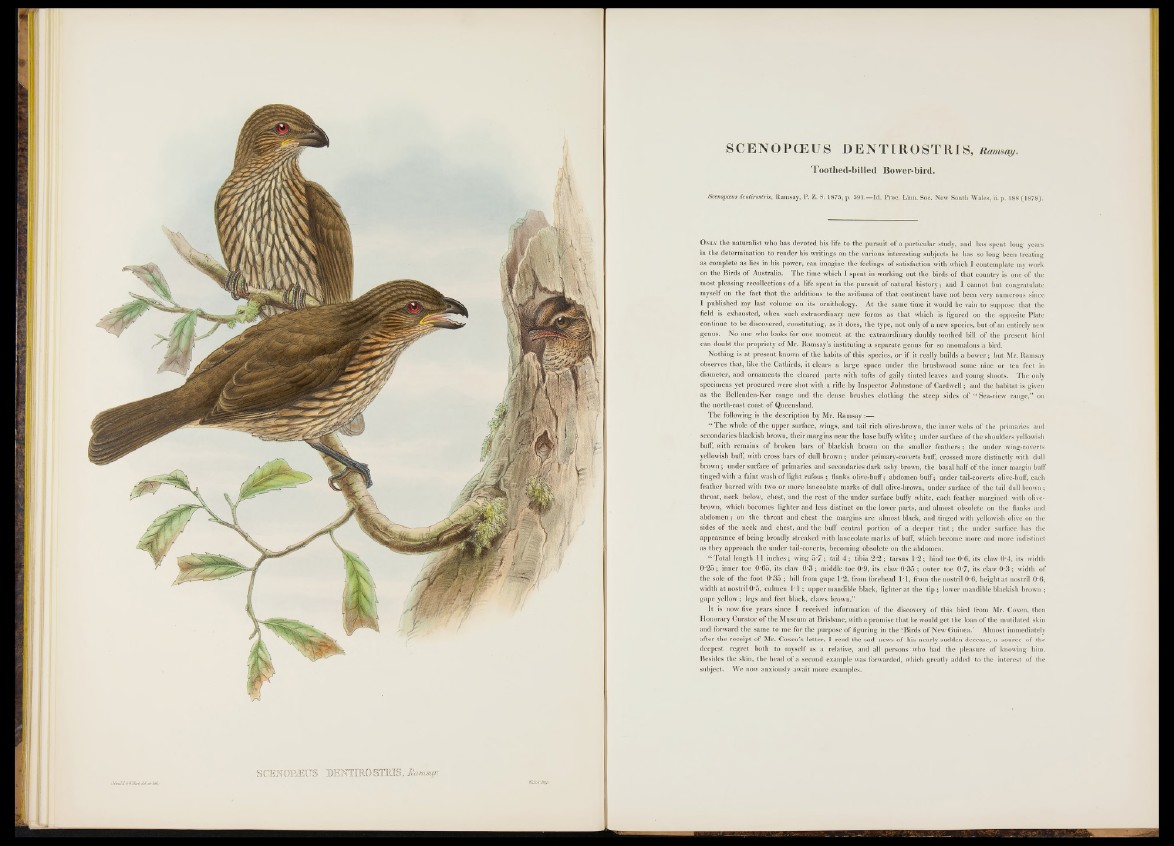
J.Gatl<l k WMart_ dtl/ & hth*.
SCENOBEUS BBNHR0 STRIS, Ram scgr.
Walter, imp.
SCENOPGEUS DENTIROSTRIS , Ramsay.
Toothed-billed Bower-bii'd.
Scenopoeus dentirostris, Ramsay, P. Z. S. 1875, p. 591.—Id. Proc. Linn. Soc. New South Wales, ii. p. 188 (1878).
O n l y the naturalist who has devoted his life to the pursuit o f a particular study, and has spent long years
in the determination to render his writings on the various interesting subjects he has so long been treating
as complete as lies in his power, can imagine the feelings o f satisfaction with which I contemplate my work
on the Birds o f Australia. The time which I spent in working out the birds o f that country is one o f the
most pleasing recollections o f a life spent in the pursuit o f natural history; and I cannot but congratulate
myself on the fact that the additions to the avifauua of that continent have not been very numerous since
I published my last volume on its ornithology. At the same time it would be vain to suppose that the
field is exhausted, when such extraordinary new forms as that which is figured on the opposite Plate
continue to be discovered, constituting, as it does, the type, not only o f a new species, but of an entirely new
genus. No one who looks for one moment at the extraordinary doubly toothed bill o f the present bird
can doubt the propriety o f Mr. Ramsay’s instituting a separate genus for so anomalous a bird.
Nothing is at present known of the habits o f this species, or if it really builds a bower; but Mr. Ramsay
observes that, like the Catbirds, it clears a large space under the brushwood some nine or ten feet in
diameter, and ornaments the cleared parts with tufts o f gaily tinted leaves and young shoots. The only
specimens yet procured were shot with a rifle by Inspector Johnstone o f Cardwell; and the habitat is given
as the Bellenden-Ker range and the dense brushes clothing the steep sides of “ Sea-view range,” on
the north-east coast o f Queensland.
The following is the description by Mr. Ramsay :—
“ The whole o f the upper surface, wings, and tail rich olive-brown, the inner webs of the primaries and
secondaries blackish brown, their margins near the base buffy w hite; under surface o f the shoulders yellowish
buff, with remains o f broken bars o f blackish brown on the smaller feathers ; the under wing-coverts
yellowish buif, with cross bars o f dull brown; under primary-coverts buff, crossed more distinctly with dull
brown ; under surface o f primaries and secondaries dark ashy brown, the basal half o f the inner margin buff
tinged with a faint wash o f light rufous; flanks olive-buff; abdomen buff; under tail-coverts olive-buff, each
feather barred with two or more lanceolate marks of dull olive-brown, under surface o f the tail dull brown ;
throat, neck below, chest, and the rest of the under surface buffy white, each feather margined with olive-
brown, which becomes lighter and less distinct on the lower parts, and almost obsolete on the flanks and
abdomen ; on the throat and chest the margins are almost black, and tinged with yellowish olive on the
sides o f the neck and chest, and the buff central portion o f a deeper t in t ; the under surface has the
appearance o f being broadly streaked with lanceolate marks o f buff, which become more and more indistinct
as they approach the under tail-coverts, becoming obsolete on the abdomen.
“ Total length 11 inches; wing 5 ' 7 ; tail 4 ; tibia 2*2; tarsus 1*2; hind toe 0‘6, its claw 0-4, its width
0 2 5 ; inner toe 0 ‘65, its claw 0*3 ; middle toe 0 -9, its claw 0'35 ; outer toe 0 '7, its claw 0*3 ; width of
the sole o f the foot 0 -35 ; bill from gape 1*2, from forehead IT , from the nostril 0 -6, heightat nostril 0 -6,
width at nosti’il 0 ’5, culmen 1*1; upper mandible black, lighter at the tip; lower mandible blackish brown ;
gape yellow; legs and feet black, claws brown.”
It is now five years since I received information o f the discovery o f this bird from Mr. Coxen, then
Honorary Curator o f the Museum at Brisbane, with a promise that he would get the loan o f the mutilated skin
and forward the same to me for the purpose o f figuring in the ‘Birds o f New Guinea.’ Almost immediately
after the receipt o f Mr. Coxen’s letter, I read the sad news o f his nearly sudden decease, a source o f the
deepest regret both to myself as a relative, and all persons who had the pleasure o f knowing him.
Besides the skin, the head o f a second example was forwarded, which greatly added to the interest o f the
subject. We now anxiously await more examples.